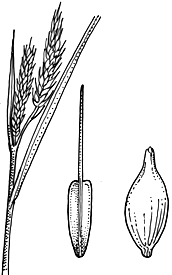Carex brownii Tuck. APNI* Synonyms: Carex striata R.Br. APNI*

Description: Rhizome long; shoots loosely tufted. Culms erect, trigonous, noded, smooth below, scabrous above, 20–100 cm long, 1–1.3 mm diam.
Leaves shorter than culms; blade 4–6 mm wide; sheath pale to dark brown; ligule obtuse.
Inflorescence erect, 2–20 cm long, with 3 or 4 spikes solitary at nodes, the lowest spike often very distant from the rest; lowest involucral bracts exceeding inflorescence. Spikes sessile, contiguous or distant, erect at maturity, 1–2.5 cm long; uppermost spike male or occasionally androgynaecandrous; lower spikes female. Glumes long-acute to truncate, with mucro as long as or exceeding body, whitish with green midrib; female glumes 3–5 mm long. Perigynia (utricles) obovoid to broad-ellipsoid, strongly many-nerved, 3.5–4 mm long, c. 1.8 mm diam., glabrous, usually dark grey-green, occasionally pale yellow-brown; beak 0.5–0.8 mm long, with apex notched. Anthers 2–3 mm long excluding appendage to 0.1 mm long. Style 3-fid.
Nut ellipsoid, trigonous in cross section, yellow-brown.
Flowering: spring–summer.
Distribution and occurrence: Grows in moist habitats such as stream banks; occasional on coast.
NSW subdivisions: NC, NT, ?CC, SC
Other Australian states: Qld Vic.
Text by K. L. Wilson (1993); edited KL Wilson (July 2016)
Taxon concept: Flora of NSW 4 (1993)
APNI* Provides a link to the Australian Plant Name Index (hosted by the Australian National Botanic Gardens) for comprehensive bibliographic data
***The AVH map option provides a detailed interactive Australia wide distribution map drawn from collections held by all major Australian herbaria participating in the Australian Virtual Herbarium project.
|


